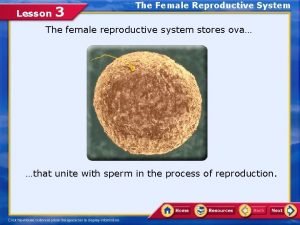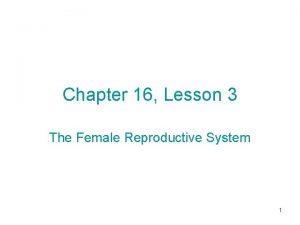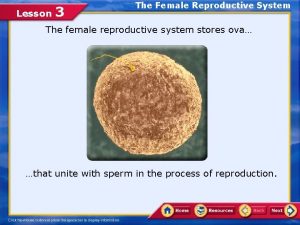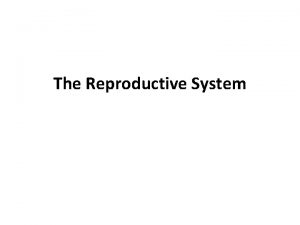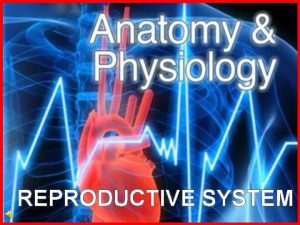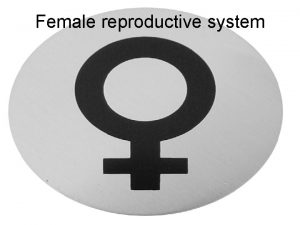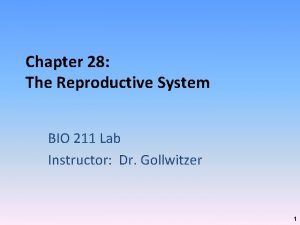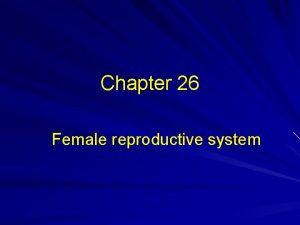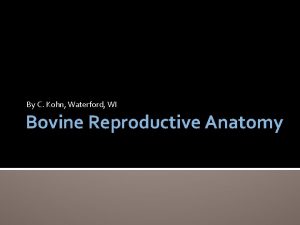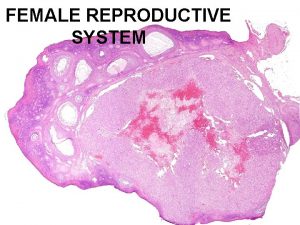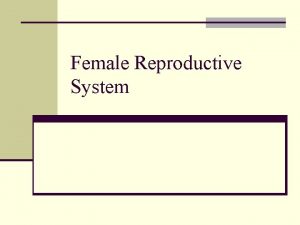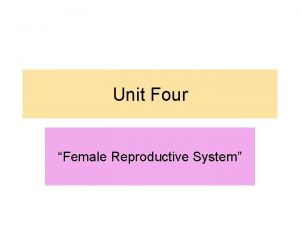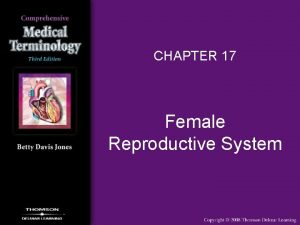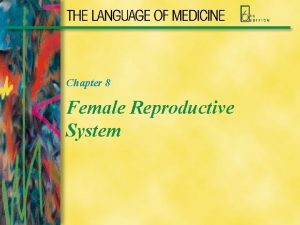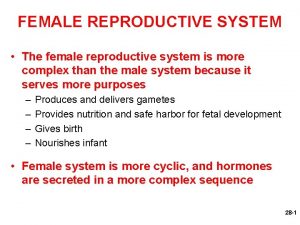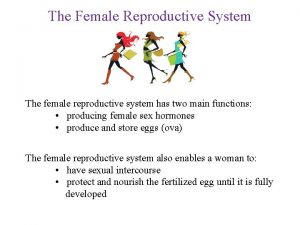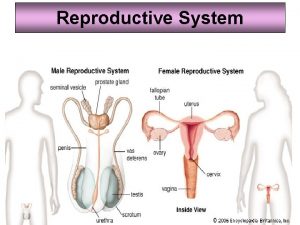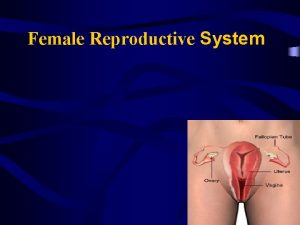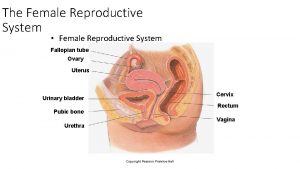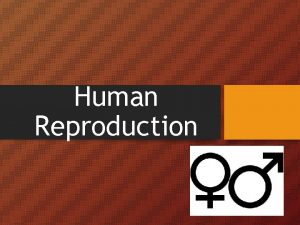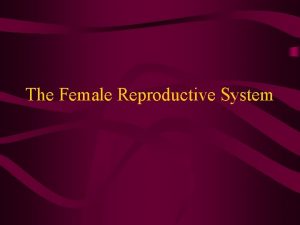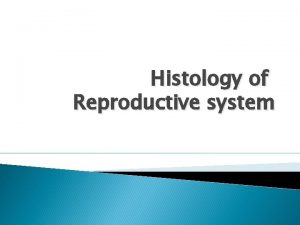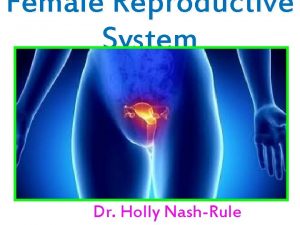The Reproductive System Lesson Eight Female Reproductive System


















- Slides: 18

The Reproductive System Lesson Eight

Female Reproductive System Function: To produce ova, the female reproductive cells n To produce the female sex hormones, progesterone and estrogen n To regulate the processes required for childbirth n

Female Structures Vulva n The external female sex organs w Clitoris, labia, vaginal opening, mons pubis Clitoris n Erectile tissue located above the vaginal opening w No known reproductive functions w Helps produce sexual arousal

Mons Pubis n Rounded fatty pad of tissue covered with pubic hair which is directly on top of the pubic bones Labia n Folds of tissue on either side of the vaginal opening w Labia majora (outer lips) and labia minora (inner lips) Vaginal Opening n Becomes visible when labia are parted

Hymen n A mucous membrane partially closing the external opening of the vagina w No known function and not present in all females Vagina (Birth Canal) n Muscular, very elastic tube that serves as a passageway to the uterus Cervix n The lower end or neck of the uterus or the opening between the uterus and the vagina Uterus n Small, muscular, pear-shaped organ about the size of a fist

Endometrium n Inner lining of the uterus, which is shed during menstruation Fallopian tubes n Pair of tubes that go from the ovaries to the uterus Ovaries n Two glands situated on either side of the uterus which produce the female sex hormones and the female reproductive cells (ova)


Menstruation Regular monthly shedding of the endometrium Usually begins around age 12 Ovaries release a mature egg cell every 28 days Average length of a menstrual cycle is 28 days Menstruation generally last 3 -7 days An ovum lives 24 hours A women loses 50 -200 ml. of blood during each menstrual period

Stages of Menstruation Preovulatory Phase: n Begins as soon as menstrual bleeding from the previous cycle has ended; endometrium thickens Ovulation n Takes place around the midpoint of the cycle (14 -16 days before the 1 st day of the menstrual flow) Postovulatory Phase n Progesterone causes the endometrium to thicken Menstrual Phase n Menstruation occurs, uterine lining is discharged


Problems of the Female Reproductive System Dysmenorrhea n Extremely painful menstruation Premenstrual Syndrome n Variety of symptoms that some women experience before their menstrual periods Toxic Shock Syndrome n Bacterial disease associated with the use of super-absorbent tampons

Male Reproductive System Function: n To produce the sperm cell w A normal healthy male produces 200 -300 million sperm a day w Sperm can live up to 6 -8 hours in the vagina and 3 -5 days in the uterus and Fallopian tubes w It takes one and half hours for sperm to reach the Fallopian tubes n To produce testosterone

Male Structures Testes or testicles n Two small glands that produce sperm and the male hormone, testosterone Seminiferous tubules n Section of the testes that produce sperm Interstitial Cells n Cells that produce testosterone Scrotum n The sac the encloses the testicles and controls the temperature of the testicles Epididymis n Large coiled tube that stores sperm after they are produced

Vas Deferens n Tube that connects the epididymis and the urethra Seminal Vesicles n Two glands that secrete a fluid which nourishes the sperm and helps them to move Prostate Gland n Gland secretes a milky, alkaline fluid to mix with sperm and major portion of semen Cowper’s Gland n Two pea size glands that secrete a clear, sticky fluid that is thought to cleanse the urethra of acid from urine w Pre-ejaculatory fluid

Urethra n Tube-like organ that serves as a passageway for sperm and urine Penis n The external organ of the male reproductive system Glans n The tip or end of the penis Foreskin n The flap of skin that covers the end of the penis w It may be removed by surgery called circumcision


Male Reproductive System Physiology Erections n Caused when veins and spongy tissue in the penis fill with blood Ejaculations n Muscles in the erect penis contract and force semen out of the penis w 300 million sperm are ejaculated in about a teaspoon of fluid Nocturnal Emissions n When the male becomes sexually excited and ejaculates during his sleep Masturbation n Sexual self-stimulation that often leads to climax or orgasm

Other Parts Anus n The opening at the end of the digestive tract where feces leaves the body Rectum n The last 6 to 8 inches of the large intestine Bladder n A sac that holds the urine produced in the kidney
 Lesson 3 the female reproductive system
Lesson 3 the female reproductive system Chapter 16 lesson 3 the female reproductive system
Chapter 16 lesson 3 the female reproductive system Lesson 3 the female reproductive system
Lesson 3 the female reproductive system Chapter 16 lesson 2 the male reproductive system
Chapter 16 lesson 2 the male reproductive system Structure of female
Structure of female Plane figures
Plane figures A short section of corrugated roadway that warns of hazards
A short section of corrugated roadway that warns of hazards Development of female reproductive system
Development of female reproductive system Female reproductive system with baby
Female reproductive system with baby Female external reproductive system
Female external reproductive system Epilization
Epilization Parts of male and female reproductive system
Parts of male and female reproductive system Mature follicle
Mature follicle Main function of female reproductive system
Main function of female reproductive system Reproductive system of pila
Reproductive system of pila Uterus pig
Uterus pig Figure 28-1 the male reproductive system
Figure 28-1 the male reproductive system Sagittal female reproductive system
Sagittal female reproductive system Female cow reproductive system
Female cow reproductive system
